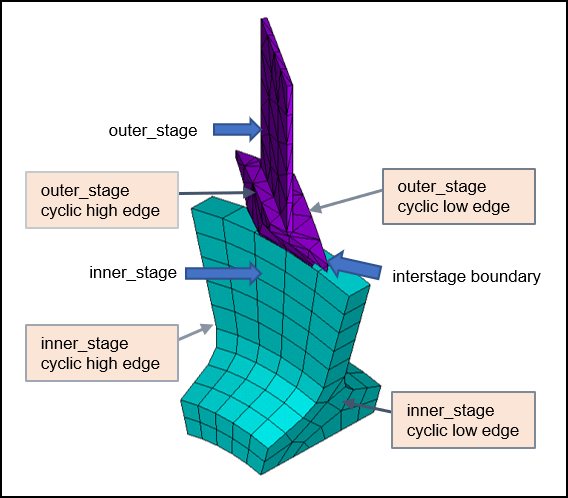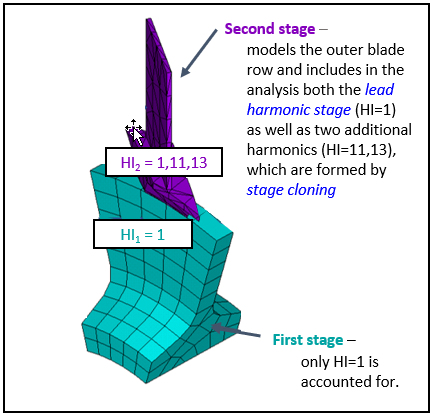Some of the terminology used in a multistage cyclic analysis is common with cyclic symmetry analysis (see Cyclic Symmetry Overview in the Cyclic Symmetry Analysis Guide).
Figure 2.1: Nomenclature of Cyclic Stages illustrates some of the features of a multistage cyclic model.
General Terms
The following terms describe multistage models and multistage phenomena.
- Base sector
The base sector refers to an original sector mesh, including constraints and other relevant boundary conditions. In the duplicate sector method used for representing cyclically symmetric systems, the base sector is duplicated (see Duplicate sector below).
- Cyclic edges
Cyclic edges are the boundaries of the cyclic sector upon which cyclic symmetry constraints are applied. See CECYCMS and Edge Component Pairs in the Cyclic Symmetry Analysis Guide. (For information on the low and high boundary properties in the Mechanical Application, see Symmetry Workflow in Mechanical in the Mechanical User's Guide.)
- Cyclic sector part
A part with cyclically symmetric geometry that is modeled using a sector with appropriate cyclic constraints. Some examples are a blade row, connectors, or a bolt hole pattern.
- Duplicate sector
One method to solve a cyclic symmetry problem is the duplicate sector method. The duplicate sector refers to the complete duplication of the base sector mesh, including constraints and other relevant boundary conditions. In the database, both base and duplicate sector models created by the user are present. See Table 3.1: Cases Requiring a Duplicate Sector.
- Interstage boundary
The interstage boundary is the boundary between two adjacent cyclic stages upon which interstage constraints will be applied (CEIMS).
- Physical stage
A physical stage is a part that is cyclically symmetric. A physical stage is modeled with a lead harmonic stage and, if applicable, secondary harmonics (or stage clones). You can connect any number of physical stages to any given stage to build a model for a multistage cyclic symmetry analysis. The only limit is that the total number of stages (lead harmonics + secondary harmonics for a multiharmonic analysis) of the entire multistage system be less than or equal to 100.
- Stage
A stage includes all necessary meshes and boundary conditions to model a single cyclically symmetric structure which will be tied to another cyclically symmetric structure. A stage must include a base sector mesh (and duplicate sector mesh if the cyclic harmonic index requires it) and cyclic symmetry constraint equations (CECYCMS). Additionally, sector-based stages may also include stage clones resulting in a stage having multiple base and multiple duplicate sector meshes, with each stage clone having a specific harmonic index for the applied cyclic constraint equations. Stages are used to model structures, parts, or bodies that make up a larger system in a multistage cyclic symmetry analysis.
Terms Related to Multiharmonic Multistage Analysis
The following terms are used to describe multistage models that include multiple harmonic indices for one or more stages.
- Harmonic Index (HI)-based Tabular Loads
Loads or boundary conditions that are applied using an HI-based table, which eliminates the need to copy loads from the base sector to duplicate sectors or stage clones. HI-based tables include the multistage harmonic index (MSHI) as a primary variable and can define loads for a single HI or for multiple harmonic indices. For details, see Harmonic Index-based Tabular Loads.
- Lead harmonic stage
The lead harmonic stage refers to the first defined harmonic in a multiharmonic group. It is often associated with the primary harmonic index of interest in the multistage solution.
- Linked harmonic index system
A linked harmonic index system is a set of coupled and relevant cyclic harmonic indices for a given multistage model. For example, for a two stage model, the set can be (HI1 = 1,HI2 = 1) to simulate the system when both stages vibrate in harmonic index 1. For a multiharmonic representation of a two stage model, the set can be (HI1 = 1,HI2 = 1,11,13) to simulate the system when both stages vibrate predominately in harmonic index 1 (See figure below).
- Multiharmonic group
A group that consists of a single lead harmonic stage and one or more secondary harmonics (or stage clones) used to account for multiple harmonic indices. For the linked harmonic index system in the figure above (HI1 = 1,HI2 = 1,11,13), the multiharmonic group is HI2 = 1,11,13.
- Stage cloning
Stage cloning is the reproduction of a cyclic sector stage (base and duplicate sector) with updated harmonic index and cyclic constraint equations (CECYCMS). Any cyclic sector stage generated to be a secondary harmonic is referred to as a stage clone, and the sector stage generated using the primary harmonic index is referred to as the lead harmonic stage.




